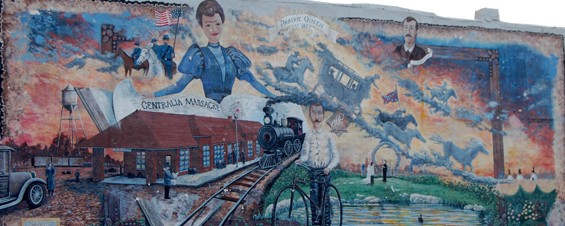Yesterday I spent the day doing my part as one of twelve members of a Sesquicentennial Working Group that will meet next month in Milwaukee as part of the annual meeting of the Organization of American Historians. Our panel was organized by the American Association for State and Local History. We are now at the stage where group members are responding to the various proposals in an attempt to facilitate as fruitful a discussion as possible once we all get together in one room.
All of the proposals are very interesting and reflect a broad range of issues that educators, public historians, and museums are facing as we make our way through the Civil War 150th. I was particularly intrigued by one case study, which focused on securing funding to properly interpret the Centralia Massacre in Missouri for students and the general public. The author, who is a history teacher, focused on the challenges of raising sufficient funds for a story that tends to fall outside of our traditional narrative of the Civil War.
The challenge that this person faces in promoting interest in and funding for the preservation and interpretation of the Centralia Massacre highlights the continued popularity of a glorified Civil War narrative. Americans are much more comfortable commemorating and remembering a war that pit brave Confederate and Union soldiers against one another, mainly on Eastern battlefields, and apart from any serious discussion of causes and consequences. This is still the case even though there has been a steady stream of scholarly studies [start with Dan Sutherland’s A Savage Conflict] devoted to the Border Wars over the past few years and online databases are also available. The story of Centralia and the war in Missouri is essential to the creation and maintenance of a sesquicentennial narrative that finally moves beyond what is still a deeply engrained Lost Cause/Reconciliationist narrative.
I’ve used the movie Ride With the Devil in my own course on the Civil War to introduce students to the Border Wars in Missouri. While it does capture some of the violence in the region, the movie’s emancipationist streak, which emerges in the final scene masks both the short- and long-term consequences of what was essentially a civil war within a civil war.
The story of Missouri’s Civil War has much in common with this nation’s military experience overseas in recent years, especially in Iraq and Afghanistan, where much of the violence is driven by local disputes among competing tribes and various other warring factions. Questions of who holds the moral high ground is difficult to discern and arguably irrelevant to understanding the complexity and depth of violence that took place in Civil War Missouri. This project fits into an important narrative that moves us beyond that of North v. South/Confederate v. Union and forces us to confront some of the tougher questions of the war.
The author concludes with the following: “Missourians no longer bushwhack each other; however, it is important to remember they once did.”
[Image source]

I happened to write a good bit about the Centralia massacre in my new book. It is a fascinating yet completely disturbing story that is riddled with atrocities. It is one of the saddest episodes I have ever researched.